
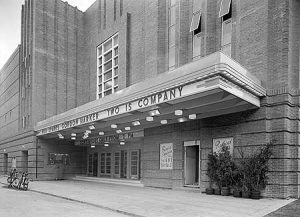
Opening week of Chester’s ODEON

Hundreds queue for opening night tickets for a film that left a lot to be desired….”Two’s Company”

1936…. an important year as far as Chester’s cinemas were concerned. The opening of it’s second “super cinema”, the ODEON, followed by the TATLER, which was built for the princely sum of £20.000. The Tatler was so well constructed, that the City Council designated it to be listed as a bomb shelter during the second World War.
The Odeon, built within the restricted plot on the corner of Hunter Street and Northgate Street was not what Oscar Deutsch, the owner of the cinema chain, wanted. Due to the proximity of the Cathedral, and it’s commanding position on the Town Hall Square, Deutsch had to settle for a building which was not of the usual Odeon design.
Check out the history pages on both these cinemas by clicking on these links> ODEON ~~~~~TATLER ~~~~~OSCAR DEUTSCH

The films that were available during this period kept the audiences happy. Click on the above frame to view

Ground works for the soon to be constructed TATLER cinema c.1935
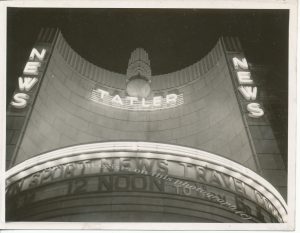
The fabulous contradiction of concave & convex with this frontage of the TATLER
____________________________________________________________________________________________________________________________________________________________
A TRACKING SHOT FROM 1927 THAT STANDS THE TEST OF TIME!

Click On The Above Frame To View To Watch This Silent Clip
________________________________________________________________________________________________________________________________________________________
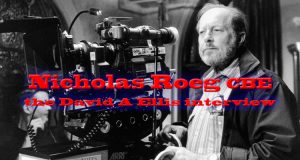
Film director Nicholas Roeg was born in 1928 and was interested in films from a very young age. His career started in a cutting room in London’s Wardour Street. He moved on to the camera department at MGM in Elstree, becoming a loader, then a focus puller, followed by camera operator, operating on a number of features including The Trials of Oscar Wilde (1960) and The Sundowners (1960). His first film as a cinematographer was Jazzboat. He also did some of the photography for Lawrence of Arabia, working with the great cinematographer Freddie Young. In 1968 Roeg turned to directing and co-directed the film Performance, starring Mick Jagger. Other notable films he directed include Don’t Look Now, Walkabout, Track 29, The Man who fell to Earth and Insignificance. One critic said that Roeg’s films shatter reality into a thousand pieces and are unpredictable, fascinating, cryptic and liable to leave you wondering what the hell happened.
How old were you when you decided to work in the film business?
I was around eighteen or twenty. The movies always appeared magical to me. I liked going to the cinema. It seemed so marvelously unusual; it had a reality to it. I would often go to the cinema with my sister when I was around twelve. I think I have kept that feeling ever since. What is reality? It’s such an extraordinary thing, the retention of the image. We take so much for granted, but it affects every single attitude we have towards life, towards any sort of continuity of existence, the past and the future.
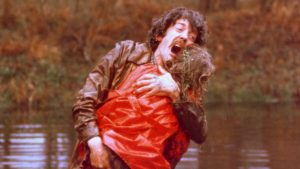
You directed Don’t Look Now – what was it like working with Donald Sutherland and Julie Christie?
They were great. They brought a certain truth to it. It wasn’t a long shoot; it was quite confined. We did four or five days in England and then five or six weeks in Venice. It is very difficult in Venice because to move large equipment you have to go by canal.
Would you tell me a bit about working with the late cinematographer Alex Thomson?
Alex was a terrific filmmaker. I remember we were shooting in Elstree on the streets and Alex got into old pram to shoot some sequences. It was hilarious. He had the heart and soul of a cinematographer. We first met at a union meeting and became great friends. Alex was innovative and rule breaking in all kind of ways before steadicam.
When you were a cinematographer did you do any effects in the camera?
Yes, I did some on the original Casino Royale (1966). I always tried to do it in the camera because if it went to a laboratory to have effects added, they didn’t always work out how you intended them. With today’s technology your intention can be created perfectly. Grading has become a completely different enterprise too. They can now do it immediately, enabling the cinematographer to see the result straight away. There are now no waiting days for it to come back and then find it is not right.
Do you have any favourites?

No, they were all part of your life. Years ago hey took much longer to make. That was a time when you could ponder film. The studios were like a film university. Gradually things speeded up because of advancing technology.
Do you think films today are as good as he old movies?
Yes, everything goes in phases. Things become original, then obvious, then normal and everyday. New filmmakers are bringing new thoughts and attitudes, and the old attitudes take time in going away. I think we are going through a swift process. The financing of movies is changing. Everything is changing: the ability, the availability and the laboratory work.
Are there any cinematographers today that you admire?
I think there are a lot. There is a long answer to that because there are so many I would hate to exclude. When I say so many, even when there are four or five, that is a lot, but there are more than that because of the amount of material being shot. There seems to be more films reviewed every week than ever before. The look of film today is wonderful.
Which film took the longest as a cinematographer?
The longest was Far from the Madding Crowd (1967) because it went through the seasons. It was a very interesting film and I enjoyed working with the director John Schlesinger very much.
David A Ellis![]() chestercinemas.co.uk
chestercinemas.co.uk
___________________________________________________________________________________________________________________________________________________________
THINGS THAT MIGHT HAVE BEEN!

Chester’s proposed 2000 seat Concert Hall. Preparatory 1945 drawings
Seen here is a 1945 artist’s impression of a Concert Hall/Culture Centre that was to have been built between the Town Hall and the Odeon. Being just after the war, more than likely money problems caused the dream to fade into oblivion. Lets hope that history does not repeat itself with the present stalled development in the same area.
chestercinemas.co.uk (c)
____________________________________________________________________________________________________________________________________________________________
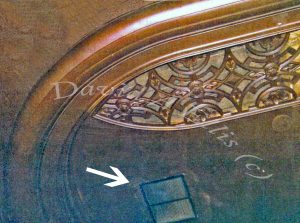
Once again, David Ellis has captured an important feature of one of Chester’s Super Cinemas. The ABC Regal.
He took this featured shot of the original ornate plaster-work of the ceiling.
On the ABC~ Multi screen alterations page, you will read about the poor handling of the conversion of this cinema. Typical is the manner in which the new intake air supply grill is set into the ceiling just below the design. This image reminds us of a masterpiece of the 1930’s design, and the total disregard for it in later years
chestercinemas.co.uk![]()
___________________________________________________________________________________________________________________________________________________________

Many thanks to our Facebook Chester Cinemas member- David Bailey who kindly supplied this piece regarding the Compton organ that was originally installed at the ABC Regal, Chester…..
Current status of the Ex-Regal Chester Compton, now close to re-entering service at the Majestic Theatre Pomona, Queensland, Australia. Click on this link>>
https://www.facebook.com/don.clark.90281943/posts/217582445642906
_________________________________________________________________________________________________________________________________________________________